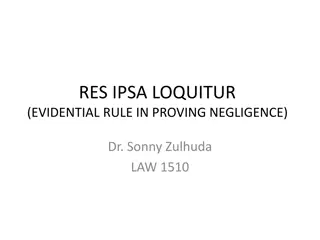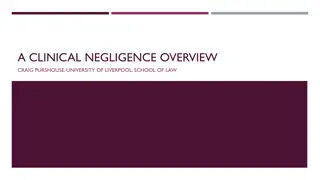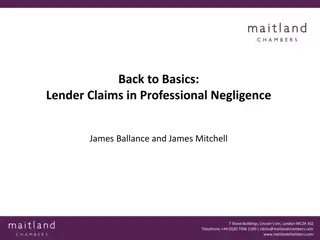Understanding Negligence in the Standard of Care
Exploring the concept of negligence in terms of the standard of care, exemplified by the case of Blyth v. The Company of Proprietors of The Birmingham Waterworks in 1856. The reasonable man test, defining the obligations of individuals to act in a manner consistent with a prudent person, is discussed within the context of liability for injury and property damage.
Download Presentation

Please find below an Image/Link to download the presentation.
The content on the website is provided AS IS for your information and personal use only. It may not be sold, licensed, or shared on other websites without obtaining consent from the author. Download presentation by click this link. If you encounter any issues during the download, it is possible that the publisher has removed the file from their server.
E N D
Presentation Transcript
Liability in negligence for injury to people and damage to property Negligence: Standard of Care
Learning Objectives By the end of the session you should be able to: Explain what is meant by the standard of care. 1. Explain the reasonable man test. 2.
Standard of Care In order to determine whether someone has breached a duty of care, the standard of care must be considered. The standard of care is that of the reasonable person. A person is not required to show a standard of care greater than that of the reasonable person. A person will be liable if they have shown a standard of care less than that of the reasonable person.
Blyth v The Company of Proprietors of The Birmingham Waterworks [1856]: The Standard of Care The standard of care was defined in Blyth v The Company of Proprietors of The Birmingham Waterworks [1856]. Facts: There had been some of the coldest frosts on record causing the water in a water main to freeze and expand pushing a fireplug out. Fireplugs were used in order to provide easy access to a water supply in the event of a fire. Water had escaped and damaged a property. The owner sued for negligence on the basis that the defendants had not kept their water-pipe and the fireplug in proper order.
Blyth v The Company of Proprietors of The Birmingham Waterworks [1856]: The Standard of Care The High Court held that there had been no negligence. Alderson, B. stated: Negligence is the omission to do something which a reasonable man, guided upon those considerations which ordinarily regulate the conduct of human affairs, would do, or doing something which a prudent and reasonable man would not do. The defendants might have been liable for negligence, if, unintentionally, they omitted to do that which a reasonable person would have done, or did that which a person taking reasonable precautions would not have done. The result was an accident, for which the defendants cannot be held liable. http://www.bailii.org/ew/cases/EWHC/Exch/1856/J65.html
Blyth v The Company of Proprietors of The Birmingham Waterworks [1856]: An Important Note A common mistake is to think that the tort of negligence only began in 1932 with Donoghue v Stevenson. Negligence was well-known to English law before 1932. However, it was much more limited in scope and duty of care had not yet been extended to the neighbour principle stated by Lord Atkin.
Reasonable Man Test The reasonable man test is sometimes referred to as the reasonable person test. It is regarded as an objective test. The judge or jury will determine whether a person has acted negligently by comparing his or her act or omission with the behaviour of the reasonable man.
The Man on the Clapham Omnibus Activity Use a dictionary to find out the meaning of omnibus . Use a multimedia device to access Lord Reed s explanation of the reasonable man test in: Healthcare at Home Limited v The Common Services Agency [2014] UKSC 49 paras 1-4. https://www.supremecourt.uk/decided- cases/docs/UKSC_2013_0108_Judgment.pdf











![Understanding Negligence Liability in Donoghue v. Stevenson [1932]](/thumb/198881/understanding-negligence-liability-in-donoghue-v-stevenson-1932.jpg)













